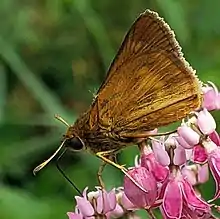Euphyes conspicua
Euphyes conspicua, the black dash, is a butterfly of the family Hesperiidae. The species was first described by William Henry Edwards in 1863.[1] It is found in the upper Midwest of North America, from eastern Nebraska east to southern Ontario and along the central Atlantic Coast from Massachusetts south to south-eastern Virginia.[2]
| Black dash | |
|---|---|
 | |
| Scientific classification | |
| Kingdom: | Animalia |
| Phylum: | Arthropoda |
| Class: | Insecta |
| Order: | Lepidoptera |
| Family: | Hesperiidae |
| Genus: | Euphyes |
| Species: | E. conspicua |
| Binomial name | |
| Euphyes conspicua (W. H. Edwards, 1863) | |
| Synonyms | |
| |
The wingspan is 32–42 mm. The upperside is black. The underside of the hindwings is reddish brown with a curved band of yellow spots. Adults are on wing from June to August in one generation per year. They feed on the nectar of various flowers.
The larvae feed on Carex stricta and possibly other Carex species.
Subspecies
E. conspicua has three subspecies:[3]
- E. c. buchholzi (P. Ehrlich and Gillham, 1951)
- E. c. conspicua (W. H. Edwards, 1863)
- E. c. orono (Scudder, 1872)
References
- Savela, Markku (November 29, 2015). "Euphyes conspicua (Edwards, 1863)". Lepidoptera and Some Other Life Forms. Retrieved October 21, 2019.
- Lotts, Kelly & Naberhaus, Thomas (2017). "Black Dash Euphyes conspicua (W.H. Edwards, 1863)". Butterflies and Moths of North America. Retrieved October 21, 2019.
- "Euphyes conspicua". Integrated Taxonomic Information System. Retrieved January 1, 2014.
This article is issued from Wikipedia. The text is licensed under Creative Commons - Attribution - Sharealike. Additional terms may apply for the media files.